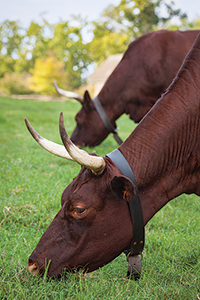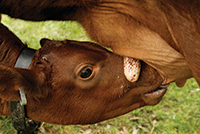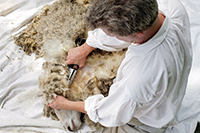Living History
Colonial Williamsburg marks the 30th anniversary of its Rare Breeds program, which seeks to preserve the lineage of animals facing the prospect of extinction.
by Ben Swenson
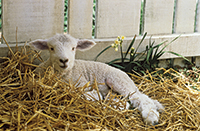
Barbara Lombardi
Saving rare breeds became a natural extension of Colonial Williamsburg's preservation mission.
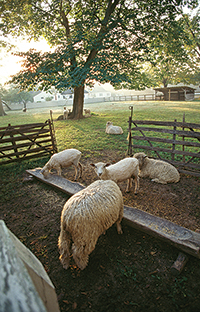
Dave Doody
A few years after the Milking Devons arrived, the Rare Breeds program expanded with the introduction of Leicester Longwool sheep.
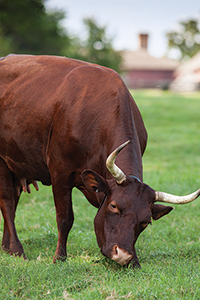
Tom Green
As the bicentennial approached in 1976, the search for breeds familiar to Colonial Americans raised concerns about genetic loss.
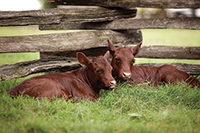
Tom Green
Milking Devons worked well under harness and also produced prodigious amounts of rich milk.
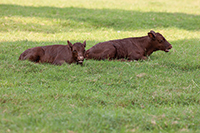
Tom Green
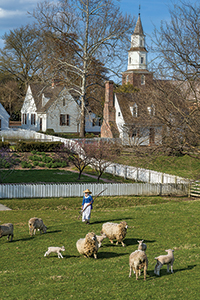
Dave Doody
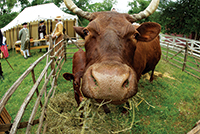
Dave Doody
Rare breeds animate the Enlightenment, a period when people used science and reason to solve problems.
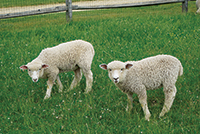
Jeanne Asplundh
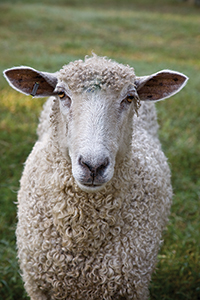
Barbara Lombardi
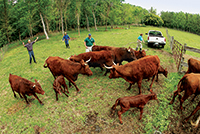
Dave Doody
Colonial Williamsburg sends Leicester Longwools and Milking Devons to homes beyond the Historic Area.
George Washington Parke Custis was the step-grandson and protégé of his famous namesake, who adopted and raised him as a son. An ample inheritance left Custis time for dabbling in all sorts of pursuits — the arts and oratory, preserving the memory of the Father of His Country, and a special favorite, agriculture. Custis was really into sheep.
Like his step-grandfather, Custis thought that sheep were vital for America's future, so he did his part to improve the stock. He selected and bred the best rams and ewes, even introduced some of Mount Vernon's flock after Washington's 1799 death. Custis created a breed that produced more than twice the fleece and meat as common sheep found in the American countryside.
Custis' sheep grazed on the rolling hillsides of his plantation, Arlington, land that would one day become Arlington National Cemetery. Custis hosted annual sheep-shearings there. He erected a marquis tent Washington used while commander-in-chief of the Continental Army. Under that honored canvas, Custis delivered speeches and awarded prizes for the best shearers and highest-quality cloth. It was an occasion to showcase the most promising American sheep, including his own, called the Arlington Improved.
But even the Arlington Improved's illustrious provenance couldn't stave off a pitiable fate, one that has befallen thousands of other breeds. The odds were against the sheep Custis created. The Arlington Improved went extinct.
Animals were central to our ancestors' lives because they furnished fundamental needs: flesh for food, fleece for clothing, muscle for moving shelters' heavy components. People still rely on animals, of course, but as societies became more urban and industrial, the relationship to livestock and poultry changed. Farmers raised fewer breeds on more acreage that was increasingly out of sight for the growing number of city dwellers. Breeds that represented a time and place in history began to fade into obscurity. And with those breeds went all their distinct attributes — appearance, demeanor, flavor — that created an irreplaceable snapshot of the climate they lived in and the forage that fed them.
That's why Colonial Williamsburg's Coach and Livestock department is now celebrating a couple of important milestones. Next year will mark three decades since the first American Milking Devon cattle came to town. For the Leicester Longwool sheep, it has been nearly as long — a quarter century. This is an occasion to celebrate the longevity and success of these cornerstones of Colonial Williamsburg's Rare Breeds program. These creatures unlock the past in ways other sources do not, but the anniversary of their arrival signals something larger, too — a growing recognition of the need to preserve genetic diversity as modern agriculture does more with fewer breeds. Rare breeds are a special kind of history.
The animals that lived alongside Colonial American farmers were not breeds as we understand them today. There were not many hard-and-fast standards for appearance or behavior of particular types of animals, and well into the 18th century, few farmers or scientists rigorously practiced selective mating.
In contemporary descriptions of livestock, specific breeds are almost never mentioned. Take the lost-and-found advertisements in just the single April 9, 1767, issue of The Virginia Gazette. “Taken up, in Louisa, a bay horse, about 4 feet 6 inches high, with a star on his forehead,” says one listing. Another advertised finding “5 hogs ... Three sows, two of them white, marked with a crop and underkeel in the left ear.” Notices like these didn't mention, say, a Canadian draft horse or Gloucestershire Old Spots hogs along with the distinguishing features because there really were no such categories yet.
But in the days before long-distance travel was common, geographical barriers were all but insurmountable, and local populations of domestic animals were genetically isolated, so they often evolved characteristics reflective of their specific environments. Icelandic chickens came to do well in cold weather and bororo cattle developed long legs so they could thrive on the wide-open African savannah. Others evolved traits pleasing to people's palates. Hogs from Berkshire in England, for instance, were known for their exceptionally tasty flesh.
The Enlightenment helped to establish the notion that people could accelerate the process of gaining desired traits. The breeds that resulted from mating selected individuals and their descendants were pioneers in an agricultural revolution, living examples of a period when humans first took wide advantage of their power of creation. The Englishman Robert Bakewell selectively bred horses, cattle, pigs and sheep on his farm in Leicestershire, and with the latter produced a breed renowned for its desirable fleece and meaty body. Soon many husbandmen invested in better livestock. Noted The Virginia Gazette of March 3, 1768: “It is said the American colonies are sparing no expense to be furnished with the best rams and sheep, in order to promote the breed.”
As preferences changed and better methods of agriculture came along, farmers improved upon a handful of select breeds that offered the most potential for return. Others died off. Today, for instance, a dozen white eggs in an American supermarket likely come from Leghorn hens because they lay some 300 eggs per year (twice the amount of the best layers in the mid-20th century). Other breeds couldn't compete.
Ahead of the 1976 bicentennial, the search for breeds familiar to Colonial Americans turned up precious few and cast light on just how much of this living history had disappeared. A coalition of farmers, historians and curators resolved to stem the outgoing tide of genetic loss. Living history museums began exploring the preservation of old breeds. An organization was formed that would eventually grow to be what is today called The Livestock Conservancy. Colonial Williamsburg found itself in a position to become part of the solution.
In 1986, the Colonial Williamsburg Coach and Livestock department inaugurated its Rare Breeds program with the introduction of Nora, a Milking Devon cow, to the Historic Area. More than a dozen Milking Devons soon followed her.
“There were all these different programs that were beginning to take off around the world and I knew we also had the resources to make that happen,” says Richard Nicoll, retired director of Coach and Livestock. “Colonial Williamsburg was working to preserve buildings, artifacts and trades, trying to retain this history, so I thought we should try to save these old breeds, as well.”
Milking Devons were the breed that most closely resembled the cattle many Colonial Americans kept on hand. Cattle from Devonshire, England, had been imported into New England as early as 1623 and references to red cattle were peppered throughout early American newspapers, as in a notice in a October 1773 issue of The Virginia Gazette that reported finding “a THREE YEAR OLD STEER, of a dark red Colour.”
Englishmen in the Milking Devons' country of origin offered insight into the breeds' suitability for middling farmers. “The Devons are the speediest work oxen in England and trot well under harness,” wrote Robert Bakewell. His contemporary, the Rev. Richard Polwhele, said they were “the finest cattle: they are a healthy breed and easily fed. They are fleshy with small bones and they bear the best weight upon the most saleable parts.” And the breed was known to produce prodigious amounts of rich milk. In other words, the Milking Devon was a tidy multi-purpose tool — offering muscle, meat and milk — in an age when owning different cattle for each purpose made little sense.
As cattle became specialized, the number of Milking Devons declined. The breed went extinct in England. There were fewer than 100 in the world. It was then that the breed came to Williamsburg.
A few years after the Milking Devons arrived, the Rare Breeds program expanded with the introduction of Leicester (pronounced “Lester”) Longwool sheep. These were sheep that Bakewell had developed in the mid-18th century. They had long fleece and ample flesh (lamb and mutton claimed a much larger share of Americans' diets than they do today). In fact, Custis intentionally introduced Bakewell's breeding stock when he improved his Arlington sheep.
“Bringing in a rare breed of sheep seemed like a natural progression after the Milking Devons because there are so many references to sheep in the 18th century,” says Elaine Shirley, manager of the Rare Breeds program. “George Washington bred sheep. Thomas Jefferson said that every county should keep a good ram for breeding.”
Finding Leicester Longwool sheep to bring on board turned out to be a difficult task because they were so uncommon. Like some other 18th-century breeds, Leicester Longwools nearly disappeared after husbandmen created new breeds of sheep with more appealing characteristics.
When Nicoll and Shirley looked for a Leicester Longwool in the 1980s, they found just a single ram left in North America. He proved unusable to establish a flock. For one, he wasn't the best example of a Leicester Longwool. And his breed characteristics soon proved not to matter; he died senselessly in 1988 at the hands of vandals in the pasture behind Wetherburn's Tavern.
The silver lining of that crime was that it raised awareness and, importantly, funds that allowed Colonial Williamsburg to search the world over for more Leicester Longwools. There turned out to be a number of healthy flocks in the Australian island state of Tasmania. Ivan Heazlewood, a Tasmanian farmer whose family had tended Leicester Longwools for generations, helped gather and arrange importing of a flock in 1990.
For a quarter century, Leicester Longwools have been delighting visitors to Colonial Williamsburg's Historic Area. The shaggy sheep can often be found lazing in grassy pastures chewing their cud, not a care in the world. In pastures nearby guests might also have occasion to see the graceful wanderings of the even-tempered Milking Devons, their curving horns, amber coats and compact frames much different than the cattle foraging along stretches of modern roadsides.
The Milking Devons and Leicester Longwools are more than just lawn ornaments. Historic Foodways and other trades use the meat, fibers and power they provide, allowing guests to visualize the direct, intuitive relationship people have with animals who provide products, a link that's been concealed by modern agriculture. Rare breeds also animate the Enlightenment, a period when people used science and reason to solve problems and concoct revolutionary ideas about their relationship to the world around them.
The success of Milking Devons and Leicester Longwools allowed Colonial Williamsburg's Rare Breeds program to expand further to include select examples of horses, chickens and pigs, domestic animals that were familiar to early Americans of every social station.
Beyond the living history lessons, rare breeds, and especially the Milking Devons and Leicester Longwools, have yet another purpose: preserving genetic diversity. There's a chance that the traits rare breeds express, those that have been improved upon or bred out of modern animals, could be needed by scientists or farmers one day.
That preservation, Nicoll explains, requires a modicum of restraint. “From early on, I insisted that we not have too many breeds. Then you're not really preserving them; you're showing them.”
For Nicoll, Shirley and the rest of the Rare Breeds team, that larger goal of preservation meant that they'd have to look beyond Colonial Williamsburg to ensure the well-being of the handful of breeds they aimed to sustain.
Northwest of Philadelphia, in the leafy suburb of Fort Washington, Pa., lies Willow Brook Farm, a 10-acre expanse anchored by a collection of 18th-century stone-and-wood buildings that have been around since as early as 1714. Willow Brook Farm is the home of Jeanne Asplundh, a longtime Colonial Williamsburg supporter and volunteer; who has interpreted 18th-century spinning and wool production in the Historic Area for two decades.
Beyond making the long trips south most months, Asplundh helps Colonial Williamsburg in another way. Leicester Longwools graze on the verdant hillsides of Willow Brook Farm.
In 1990, Asplundh and her late husband, Barr Asplundh, provided financial and logistical support for importing of Leicester Longwools to the United States. Most of the sheep went to Colonial Williamsburg, but a couple stayed with the Asplundhs at Willow Brook Farm, forming the nucleus of a thriving flock. To this day, Asplundh brings in a Leicester Longwool ram from Colonial Williamsburg each year to her farm to breed her ewes.
Asplundh sells individual sheep to breeders and other farmers around the country. She also spins the wool shorn from her flock of Leicesters, which currently includes eight ewes and their lambs. “This is not only about preserving a rare breed, and the characteristics that have been lost over time, this is also about preserving history,” she says.
Flocks like Asplundh's are vital. “I wanted to make sure that some freak disaster here in Williamsburg wouldn't wipe out every Leicester Longwool ram in the country,” Shirley says. “I also wanted to see how the sheep would do outside of this specific environment, so we partnered with experienced farmers to establish satellite flocks.”
After the original flocks at Colonial Williamsburg and Willow Brook Farm got settled, 10 satellite flocks took root at distant farms. To date, there are more than 130 Leicester Longwool breeders around the United States, as far west as Washington state. That's a remarkable recovery given that the breed returned to North America only a quarter century ago. And Leicester Longwools aren't the only rare breed Colonial Williamsburg sends to homes beyond the Historic Area; the Coach and Livestock department also sells Milking Devons and Nankin chickens.
The success of the Rare Breeds program is worth celebrating, and that's precisely what Colonial Williamsburg will be doing Nov. 14-15. A weekend event filled with lectures and demonstrations with Leicester Longwools and other rare breeds will pay tribute to the people and animals who brought this breed back from the brink of extinction.
The Leicester Longwools' crimped, frizzy locks are more than simply a spinner's delight; they and all the other rare breeds are a sliver of the past, a time machine that allows us to leave the 21st century and behold living, breathing, reproducing creatures known to people long ago.

